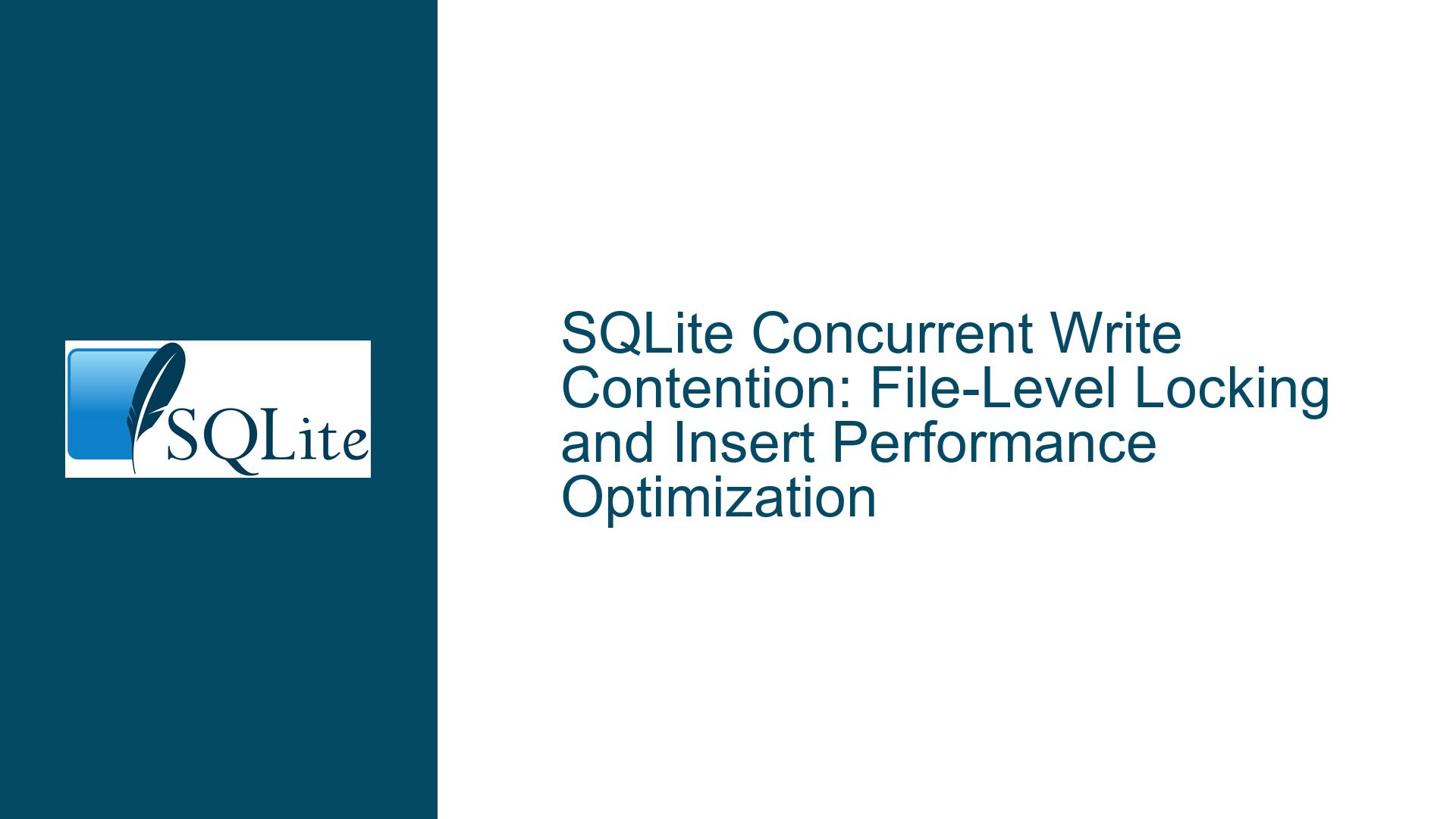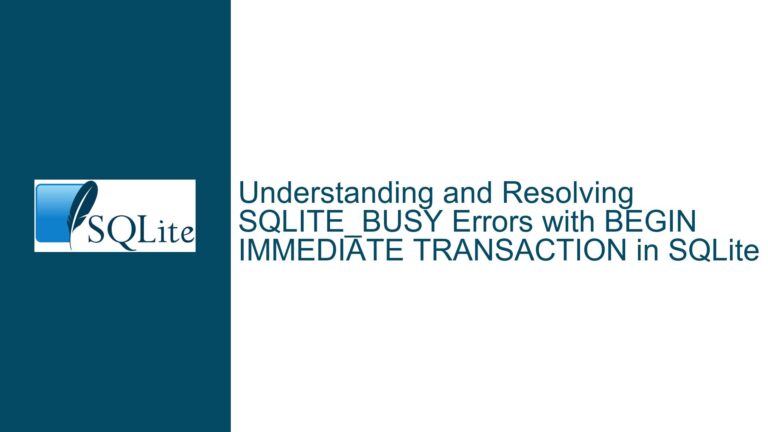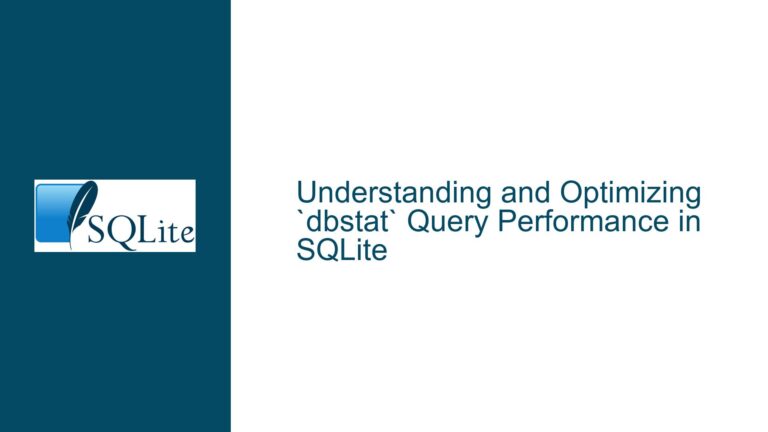SQLite Concurrent Write Contention: File-Level Locking and Insert Performance Optimization
Issue Overview: Understanding SQLite’s Locking Mechanism and Insert Performance Bottlenecks
SQLite is a widely-used embedded database engine known for its simplicity, portability, and reliability in low-to-moderate concurrency scenarios. However, developers migrating from server-based databases like MySQL or PostgreSQL often encounter unexpected performance degradation when handling concurrent write operations. The root cause lies in SQLite’s architecture: it employs database-level locking rather than row-level or table-level locking. This design choice simplifies transaction management and ensures ACID compliance but introduces contention when multiple threads or processes attempt simultaneous writes to the same database file.
In the context of the discussed problem, a developer is using SQLite as a local cache layer for a distributed system where client requests from multiple threads perform frequent inserts. The observed slowness stems from serialized write operations enforced by SQLite’s locking protocol. Unlike MySQL’s InnoDB engine—which allows concurrent row modifications through multi-version concurrency control (MVCC)—SQLite serializes all write transactions at the database file level. This means that even unrelated inserts from different threads must wait for exclusive access to the database file, leading to queueing delays and reduced throughput.
The locking mechanism operates through five progressively restrictive states: UNLOCKED, SHARED, RESERVED, PENDING, and EXCLUSIVE. When a write operation begins, SQLite transitions from SHARED (read access) to RESERVED (intent to write), then to EXCLUSIVE (actual write). During this process, other writers are blocked until the EXCLUSIVE lock is released. This becomes problematic in high-concurrency environments where multiple threads compete for write access, creating a bottleneck.
Possible Causes: Factors Contributing to Write Contention and Slow Insert Performance
1. Database-Level Locking Granularity
SQLite’s foundational design prioritizes simplicity and portability over fine-grained concurrency. The entire database file is treated as a single unit for locking purposes. This approach eliminates the overhead of managing row-level locks but makes parallel write operations impossible. Applications that require concurrent writes from multiple threads or processes will experience contention, as each write transaction must acquire an EXCLUSIVE lock.
2. Inefficient Transaction Batching
Developers accustomed to auto-commit modes in other databases may inadvertently execute each INSERT statement as a separate transaction. In SQLite, every explicit or implicit transaction (including single-statement operations) requires acquiring and releasing the EXCLUSIVE lock. This results in excessive disk I/O and lock cycling, amplifying latency. For example, inserting 1,000 rows individually could trigger 1,000 lock acquisitions, whereas a single batched transaction would require only one.
3. Suboptimal Write-Ahead Logging (WAL) Configuration
The Write-Ahead Logging mode (WAL) is a powerful feature that allows concurrent reads and writes by separating write operations into a WAL file while readers access the main database. However, misconfiguring WAL parameters—such as failing to adjust the synchronous pragma or neglecting checkpointing—can lead to uncontrolled WAL file growth, increased I/O latency, or even data loss in edge cases. Additionally, WAL does not eliminate write contention; concurrent writers still serialize their operations.
4. File System and Hardware Limitations
SQLite’s performance is tightly coupled with the underlying file system’s ability to handle atomic writes and locks. Network-mounted drives, legacy file systems without robust POSIX compliance, or hardware with slow seek times (e.g., rotational disks) exacerbate locking delays. Furthermore, anti-virus software or backup tools that scan modified files can introduce unexpected pauses during lock acquisition.
5. Threading Model and Connection Management
Creating multiple database connections within the same thread or sharing a single connection across threads violates SQLite’s thread safety guarantees. Even when using the serialized threading mode (the default in modern SQLite builds), improper connection pooling can lead to suboptimal lock negotiation. For instance, a connection pool that oversubscribes active connections might starve writers by retaining locks longer than necessary.
Troubleshooting Steps, Solutions & Fixes: Mitigating Lock Contention and Optimizing Insert Throughput
1. Leverage Write-Ahead Logging (WAL) Mode with Tuned Parameters
Enabling WAL Mode
Switch from the default rollback journal to WAL mode to decouple reads from writes:
PRAGMA journal_mode=WAL;
This allows concurrent readers to access the database while a writer is active, though writers still serialize. WAL mode reduces the frequency of EXCLUSIVE lock acquisitions by appending changes to a separate file.
Adjusting Synchronous and Checkpoint Settings
Relax durability guarantees temporarily to reduce I/O waits:
PRAGMA synchronous=NORMAL; -- Instead of FULL
In NORMAL mode, SQLite flushes writes to the OS buffer but not necessarily to disk, improving throughput at the risk of data loss during power failures. Combine this with periodic manual checkpoints to prevent WAL file bloat:
PRAGMA wal_checkpoint(TRUNCATE);
2. Batch Insert Operations Within Explicit Transactions
Minimize lock cycling by grouping multiple INSERT statements into a single transaction:
# Python Example
with sqlite3.connect('cache.db') as conn:
cursor = conn.cursor()
cursor.execute("BEGIN")
for data_chunk in large_dataset:
cursor.execute("INSERT INTO cache VALUES (?, ?)", data_chunk)
cursor.execute("COMMIT")
This approach reduces the number of lock acquisitions from N (per insert) to 1 (per batch), drastically cutting overhead.
3. Shard Data Across Multiple Database Files
When horizontal scaling is feasible, distribute data into separate SQLite databases based on a sharding key (e.g., client ID, geographic region). Each database file handles its own locks independently, enabling parallel writes:
# Shard by user_id modulo 10
shard_id = user_id % 10
conn = sqlite3.connect(f'cache_shard_{shard_id}.db')
Trade-offs: Increases application complexity for querying across shards and requires a strategy for vacuuming or rebalancing shards.
4. Utilize In-Memory Databases for Non-Persistent Caches
For ephemeral data that doesn’t require durability, use :memory: databases or per-thread private databases:
# Per-thread in-memory database
def client_handler():
conn = sqlite3.connect(':memory:')
conn.execute('CREATE TABLE temp_cache (...)')
# Use conn for thread-local operations
This eliminates file I/O and locking entirely but sacrifices persistence. Data is lost when the connection closes.
5. Optimize Schema and Indexing for Write Performance
- Avoid Over-Indexing: Each index adds overhead during INSERT/UPDATE/DELETE. Periodically review and drop unused indexes.
- Use WITHOUT ROWID Tables: For tables with explicit primary keys,
WITHOUT ROWIDcan reduce storage overhead and improve write speed:CREATE TABLE cache ( id INTEGER PRIMARY KEY, data BLOB ) WITHOUT ROWID; - Preallocate Database Size: Prevent file fragmentation by preallocating space using
PRAGMA schema.page_sizeandPRAGMA schema.max_page_count.
6. Configure Busy Timeouts and Retry Logic
Set a busy timeout to allow SQLite to automatically retry lock acquisition:
PRAGMA busy_timeout = 300; -- 300 milliseconds
In application code, implement exponential backoff for write operations:
import time
def insert_with_retry(conn, query, params, max_retries=5):
for attempt in range(max_retries):
try:
conn.execute(query, params)
conn.commit()
return
except sqlite3.OperationalError as e:
if 'database is locked' in str(e):
time.sleep(2 ** attempt)
else:
raise
raise Exception("Max retries exceeded")
7. Evaluate Alternative Storage Engines or Databases
If SQLite’s locking limitations are insurmountable for the workload, consider these alternatives:
- PostgreSQL: Offers row-level locking and true concurrency but requires a server setup.
- DuckDB: An embedded analytical database with parallel query execution.
- LMDB: An ultra-fast embedded key-value store with full ACID compliance and concurrent readers/writers.
8. Profile and Monitor Lock Activity
Use SQLite’s diagnostic functions to identify contention hotspots:
SELECT * FROM pragma_lock_status;
Enable logging for lock state transitions using sqlite3_config(SQLITE_CONFIG_LOG, ...) in C or equivalent tracing in wrapper libraries.
Final Considerations
SQLite’s file-level locking is a deliberate trade-off that aligns with its use cases as an embedded database. By combining WAL mode, batched transactions, and strategic sharding, developers can mitigate contention and achieve scalable write performance. For workloads requiring high concurrent writes with row-level isolation, transitioning to a client-server database may be necessary, but SQLite remains unparalleled in scenarios where simplicity, zero-configuration, and low resource consumption are paramount.






